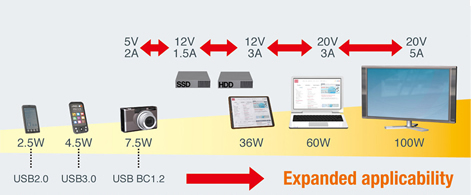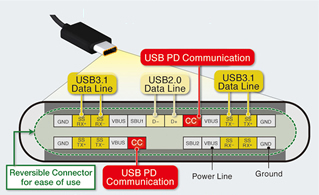ROHM's BD93FxxMWV/BD93FxxMWV series of power receiving controller ICs support the latest USB Power Delivery (USB USB PD) protocol with the USB Type-C connector.
Compatibility with USB Type-C Rev1.3 and USB PD Rev3.0 makes it possible to receive and deliver up to 100W (20V/5A).
This enables devices with larger power requirements to be driven such as notebook PCs and TVs that could not be powered by conventional USB. At the same time, it can be applied to rapid battery chargers by taking advantage of its high power supply specifications.
The BD93FxxMWV series adopts the MAP QFN package while the BD93ExxGWL series is offered in the the space-saving CSP.
And for USB Type C power receiving applications up to 15W (5V/3A) that do not require USB PD, the BD91N01NUX power receiver switch control IC is recommended.
What is USB Power Delivery?
USB Power Delivery (USBPD) is a new standard that expands the power supply capabilities of USB2.0 and USB3.1. Power supply up to 100W is achieved using the Type-C™*1) connector, making it possible to power to devices that could not be driven by conventional USB, such as notebook PCs, while enabling quick charge (shortened charge times) of mobile devices.
USBPD communication is carried out between 2 connected devices and the optimum voltage and current automatically determined after negotiating a power delivery contract. Communication is implemented on the newly established dedicated CC line that allows it to function independently of conventional USB communication. And support for Alternate-Mode control is provided for handling video signals, eliminating the need to mount a dedicated video port in notebook PCs and other devices.
In short, this new standard is capable of transmitting power, data, and video signals using a single cable, delivering unprecedented convenience and ease-of-use while contributing to environmental conservation by eliminating the need for dedicated wires for power and video.
-
USBPD Application Examples 
Automatically detects the power requirements of detected devices
and supplies up to 100W. -
USB Type-C™ Power Delivery Pin Diagram 
USBPD utilizes a private line separate from
the data line
Background
Recent years have seen a greater demand to reduce e-waste in many regions, including Europe, for example by utilizing or developing common connectors and chargers for a variety of electronic devices. As such, the latest USB connector and power transmission standards developed by USB-IF*2), which includes USB Type-C, USB Power Delivery (along with USB Superspeed), and the new DisplayPort tm Alternate Mode standard for carrying video, are garnering increased attention as a true all-in-one cable solution by making it possible to deliver high power, high-speed data, and even 4K video simultaneously over a single USB cable. This will eliminate the need for multiple dedicated cables, providing greater convenience while reducing clutter and waste.
Combining the new Type-C connector, which boasts a smaller, reversible, flippable cable design robust enough for laptops but slim enough for mobile phones, with USB PD that offers scalable power using multiple power delivery modes, results in a common, future-proof interface. ROHM leverages leading BiCDMOS processes and circuit technologies to develop USB PD controller ICs optimized for these latest USB standards.
Terminology
- *1) USB Type-C™ Standard (Type-C™ Connector)
- Defined under USB3.1, USB Type-C is a new receptacle (concave connector), plug (convex connector), and cable standard featuring a more compact, reversible design. Unlike the previous standard that required Type B connectors to be connected to downstream devices and Type A connectors at upstream devices, both ends of a Type-C cable are the same and power requirements are negotiated between connected devices to determine the upstream and downstream facing ports (UFP and DFP), providing greater convenience and utility.
- *2) USB Implementers Forum, Inc. (USB-IF)
- A standards promotion organization established in 1995 to support the creation, management, and adoption of USB standards. Currently USB-IF has over 800 member companies and continues to help bring USB-compliant devices to market.

